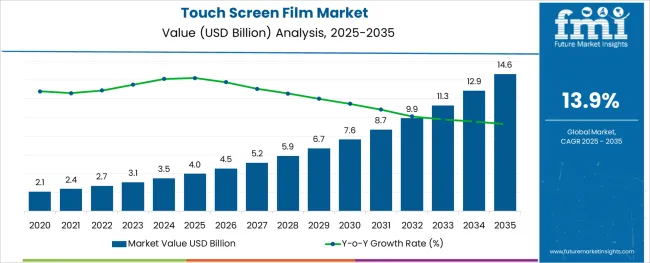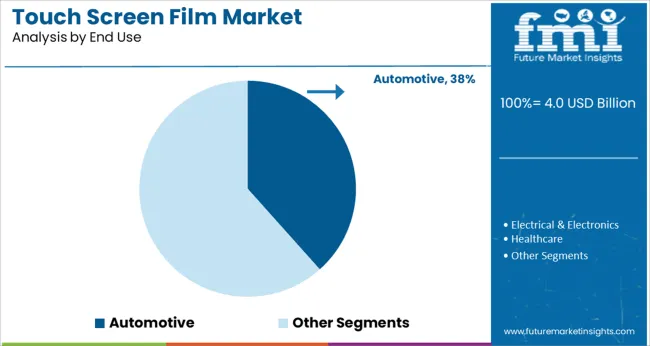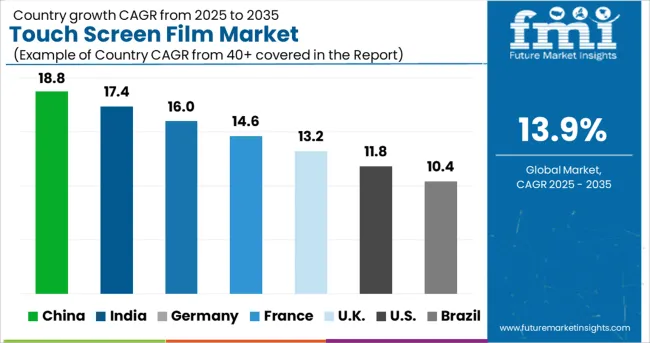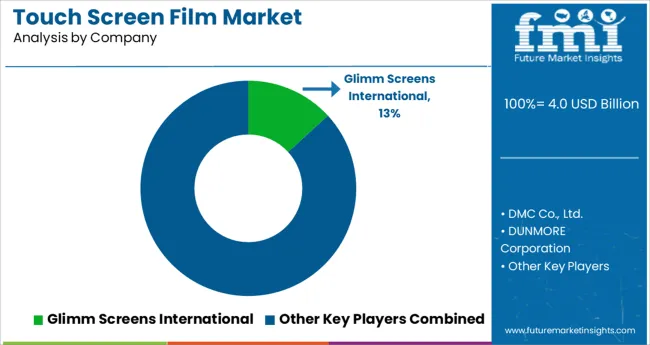The Touch Screen Film Market is estimated to be valued at USD 4.0 billion in 2025 and is projected to reach USD 14.6 billion by 2035, registering a compound annual growth rate (CAGR) of 13.9% over the forecast period.

The touch screen film market is undergoing steady expansion, supported by a surge in demand for interactive displays across consumer electronics, automotive, industrial, and medical devices. Growing expectations for screen durability, clarity, and responsiveness have pushed manufacturers to develop advanced films with properties like anti-glare, anti-smudge, UV resistance, and superior tactile feedback. Technological improvements in surface coatings and multi-layer structures are enhancing both the functional and aesthetic performance of screens.
In the automotive sector, increased adoption of infotainment systems, digital dashboards, and driver-assistance interfaces is fueling demand for highly durable and responsive touch screen films. Regulatory pressure on in-vehicle safety and digital ergonomics is also pushing OEMs to integrate premium display protection materials.
Simultaneously, sustainability initiatives and circular economy considerations are guiding R&D investments into recyclable and biodegradable film substrates. As digital interfaces become increasingly central to user experience across sectors, the market is expected to maintain upward momentum through product innovation and deeper penetration in automotive, healthcare, and industrial automation verticals.
The market is segmented by Product Type, Application, and End Use and region. By Product Type, the market is divided into Scratch Resistant Touchscreen Films, Anti-Glare/Anti-Reflective Films, Brightness Enhancement Films, and Advance Light Control Films. In terms of Application, the market is classified into Automotive Displays, Handheld Devices, Industrial Touchscreens, Kiosks / POS Systems, Touch Screen Displays, and Medical Equipment. Based on End Use, the market is segmented into Automotive, Electrical & Electronics, Healthcare, and Other Industries. Regionally, the market is classified into North America, Latin America, Western Europe, Eastern Europe, Balkan & Baltic Countries, Russia & Belarus, Central Asia, East Asia, South Asia & Pacific, and the Middle East & Africa.

The scratch resistant touchscreen films segment is anticipated to contribute 32.1% of revenue in 2025 within the product type category, securing its position as the leading segment. This leadership is driven by increased consumer demand for long-lasting display clarity and reduced screen wear, especially in high-touch applications. Scratch resistant films enhance product lifecycle and preserve user experience by maintaining optical transparency and responsiveness even after repeated use.
The growing integration of touch interfaces in automotive consoles, handheld devices, kiosks, and industrial controls has accelerated the need for enhanced surface protection. Manufacturers are increasingly incorporating multi-layer coating technologies and nano-scale hard coatings to improve resistance without compromising capacitive sensitivity.
This has reinforced adoption in both premium and mid-range product lines, with OEMs and aftermarket suppliers prioritizing scratch resistant options to enhance brand value, reduce maintenance, and support warranty performance. These advantages are expected to continue driving dominance in the product category.
Automotive displays are projected to account for 22.3% of the total market revenue by 2025 within the application category, making them a leading segment. This growth has been fueled by rising digitization in modern vehicles, with touch-based interfaces becoming standard in infotainment, navigation, climate control, and safety systems. OEMs have increasingly adopted capacitive touch panels and curved display architectures, requiring advanced films that can conform to non-flat surfaces while offering protection and clarity.
Automotive display films are engineered to withstand wide temperature fluctuations, UV exposure, and mechanical abrasion common in vehicular environments. With driver distraction regulations emphasizing safe and intuitive interfaces, high-performance films are being prioritized to maintain visibility and responsiveness.
Additionally, the rising production of electric vehicles and premium vehicle interiors has increased the deployment of large-format touchscreens, further driving demand. These trends are expected to support sustained revenue share and new product development focused on automotive-specific display films.

The automotive end use segment is expected to dominate with a 38.4% revenue share in 2025, underscoring its leadership across end use industries. This prominence is being propelled by increasing digitization within the automotive cabin environment, where user interaction is transitioning from mechanical buttons to responsive touchscreens. The deployment of advanced driver assistance systems, infotainment units, and smart dashboards is creating a growing need for durable, high-performance touch screen films.
Manufacturers are developing materials with enhanced optical bonding, anti-glare capabilities, and resistance to thermal shock to meet the stringent durability standards of the automotive sector. Furthermore, consumer preference for connected vehicles and seamless user interfaces is pushing automakers to invest in high-quality display protection solutions.
Strategic partnerships between film suppliers and automotive OEMs are also facilitating customized integration, ensuring film performance aligns with evolving vehicle design trends. These factors collectively reinforce the segment’s leading market position and are anticipated to sustain demand across the coming years.
Rising adoption of electronic gadgets such as smartphones, laptops, and tablets, innovations in touch screen films, and increasing production and sales of premium cars with multiple touchscreen displays are some of the major factors driving the growth in touch screen film market.
Touch Screen Films are being widely used in medical devices, industrial touchscreens, automotive displays, and electronic gadget displays to protect them from external hazards, reduce glaring, enhance brightness and control display light. Rising production and sales of these products will therefore continue to provide a strong thrust to the growth of touch screen film market during the forecast period.
Similarly, availability of various touch screen films including scratch resistant films, anti-glare films, advanced light control films, and others will further assist generate growth prospects within the global touch screen film market in the forthcoming years.
In addition to this, compatibility of touch screen films with numerous devices and technologies coupled with advancements in touch screen films is projected to boost their sales in future.
Thanks to these aforementioned factors, the global outlook for touch screen film market is expected to remain optimistic during the forecast period.
Despite rising applications of touch screen films, there are certain factors that are likely to act as restraining forces for market growth. Some of these factors are the high cost of advanced touch screen films and poor penetration of products like mobile phones, laptops, and premium cars with touch screen displays across various underdeveloped regions.

According to Future Market Insights, the Asia Pacific touch screen film market is set to take the top spot in terms of market share during the forecast period. Growth is attributable to the rising proliferation of touch screen smartphones and laptops due to rapidly growing population and rising disposable income across countries like China and India, availability of diverse products at affordable rates, and increasing production and sales of vehicles with large touch screens.
China remains at the epicenter of Asia pacific touchscreen film market growth due to rising sales of touchscreen smartphones, rapid growth of automotive and electronics industries, and ongoing technological advancements across the country.
Moreover, rise in the number of gamers coupled with growing trend of online education across China and India will further create sales prospects for touchscreen films during the assessment period. These touch screen films are being increasingly used for adjusting the light and brightness of electronic devices.
Western Europe accounted for a significant share of the global touch screen film market in 2025 and is projected to grow at a healthy CAGR over the forecast period, with Germany expected to steer the bulk of all regional growth. Increasing adoption of touch screen films for various purposes coupled with rapid expansion of end-use verticals is keeping sales of touch screen films afloat across Europe.
Countries like the United Kingdom and Germany are witnessing the majority of touch screen films demand due to growing adoption of electronic gadgets with touchscreens including smartphones, laptops, and medical devices. Moreover, rising popularity of premium cars across these countries is positively impacting the growth of touch screen film market.

Some of the key participants present in the global touch screen film market include 3M Company, Pro Display, Dunmore Corporation, Touch International, Inc., Holitech USA, Glimm Screens International, and Dawar Technologies among others.
These leading players are constantly upgrading their product portfolios by introducing innovative touch screen films with better features such as stain & chemical resistance, ultra-violet protection, and excellent anti reflection property. Besides this, they are adopting growth strategies such as mergers, partnerships, price reduction, strengthening of distribution channels, and digital marketing to increase their customer bases and gain a competitive edge in the market.?
| Report Attribute | Details |
|---|---|
| Growth Rate | CAGR of 13.9% from 2025 to 2035 |
| Base Year for Estimation | 2024 |
| Historical Data | 2020 to 2024 |
| Forecast Period | 2025 to 2035 |
| Quantitative Units | Revenue in million and CAGR from 2025 to 2035 |
| Report Coverage | Revenue Forecast, Volume Forecast, Company Ranking, Competitive Landscape, Growth Factors, Trends and Pricing Analysis |
| Segments Covered | Film Type, Application, Region |
| Regions Covered | North America; Latin America; Western Europe; Eastern Europe; APEJ; Japan; Middle East and Africa |
| Key Countries Profiled | USA, Canada, Brazil, Argentina, Germany, UK, France, Spain, Italy, Nordics, BENELUX, Australia & New Zealand, China, India, ASEAN, GCC, South Africa |
| Key Companies Profiled | 3M Company; Pro Display; Dunmore Corporation; Touch International, Inc.; Holitech USA; Glimm Screens International; Dawar Technologies |
| Customization | Available Upon Request |
The global touch screen film market is estimated to be valued at USD 4.0 billion in 2025.
It is projected to reach USD 14.6 billion by 2035.
The market is expected to grow at a 13.9% CAGR between 2025 and 2035.
The key product types are scratch resistant touchscreen films, anti-glare/anti-reflective films, brightness enhancement films and advance light control films.
automotive displays segment is expected to dominate with a 22.3% industry share in 2025.






Our Research Products

The "Full Research Suite" delivers actionable market intel, deep dives on markets or technologies, so clients act faster, cut risk, and unlock growth.

The Leaderboard benchmarks and ranks top vendors, classifying them as Established Leaders, Leading Challengers, or Disruptors & Challengers.

Locates where complements amplify value and substitutes erode it, forecasting net impact by horizon

We deliver granular, decision-grade intel: market sizing, 5-year forecasts, pricing, adoption, usage, revenue, and operational KPIs—plus competitor tracking, regulation, and value chains—across 60 countries broadly.

Spot the shifts before they hit your P&L. We track inflection points, adoption curves, pricing moves, and ecosystem plays to show where demand is heading, why it is changing, and what to do next across high-growth markets and disruptive tech

Real-time reads of user behavior. We track shifting priorities, perceptions of today’s and next-gen services, and provider experience, then pace how fast tech moves from trial to adoption, blending buyer, consumer, and channel inputs with social signals (#WhySwitch, #UX).

Partner with our analyst team to build a custom report designed around your business priorities. From analysing market trends to assessing competitors or crafting bespoke datasets, we tailor insights to your needs.
Supplier Intelligence
Discovery & Profiling
Capacity & Footprint
Performance & Risk
Compliance & Governance
Commercial Readiness
Who Supplies Whom
Scorecards & Shortlists
Playbooks & Docs
Category Intelligence
Definition & Scope
Demand & Use Cases
Cost Drivers
Market Structure
Supply Chain Map
Trade & Policy
Operating Norms
Deliverables
Buyer Intelligence
Account Basics
Spend & Scope
Procurement Model
Vendor Requirements
Terms & Policies
Entry Strategy
Pain Points & Triggers
Outputs
Pricing Analysis
Benchmarks
Trends
Should-Cost
Indexation
Landed Cost
Commercial Terms
Deliverables
Brand Analysis
Positioning & Value Prop
Share & Presence
Customer Evidence
Go-to-Market
Digital & Reputation
Compliance & Trust
KPIs & Gaps
Outputs
Full Research Suite comprises of:
Market outlook & trends analysis
Interviews & case studies
Strategic recommendations
Vendor profiles & capabilities analysis
5-year forecasts
8 regions and 60+ country-level data splits
Market segment data splits
12 months of continuous data updates
DELIVERED AS:
PDF EXCEL ONLINE
Touch Controller IC Market Size and Share Forecast Outlook 2025 to 2035
Touch Panel Market Size and Share Forecast Outlook 2025 to 2035
Touchless Sensing Market Size and Share Forecast Outlook 2025 to 2035
Touchless Tubes Market
Touchscreen Controller Market Growth - Trends & Outlook 2025 to 2035
Touchscreen Gloves Market
Touch Screen Module Market
Soft Touch Polyurethane Coatings Market Trends 2025 to 2035
Zero-Touch Provisioning (ZTP) Market - Growth & Demand 2025 to 2035
Soft Touch Film Market Analysis & Growth 2024-2034
Soft Touch Lamination Film Market Size and Share Forecast Outlook 2025 to 2035
Multi Touch Sensing Market Size and Share Forecast Outlook 2025 to 2035
Multi Touch Equipment Market Size and Share Forecast Outlook 2025 to 2035
Smart Touch Screen Scale Market Size and Share Forecast Outlook 2025 to 2035
Haptic Touchscreen Market Size and Share Forecast Outlook 2025 to 2035
Predictive Touch Market Size and Share Forecast Outlook 2025 to 2035
Commercial Touch Display Market Size and Share Forecast Outlook 2025 to 2035
Capacitive Touchscreen Market Insights – Growth & Forecast through 2034
Automotive Touch Screen Control Systems Market Growth - Trends & Forecast 2025 to 2035
Machine Tool Touch Probe Market Analysis - Size, Growth, and Forecast 2025 to 2035

Thank you!
You will receive an email from our Business Development Manager. Please be sure to check your SPAM/JUNK folder too.
Chat With
MaRIA